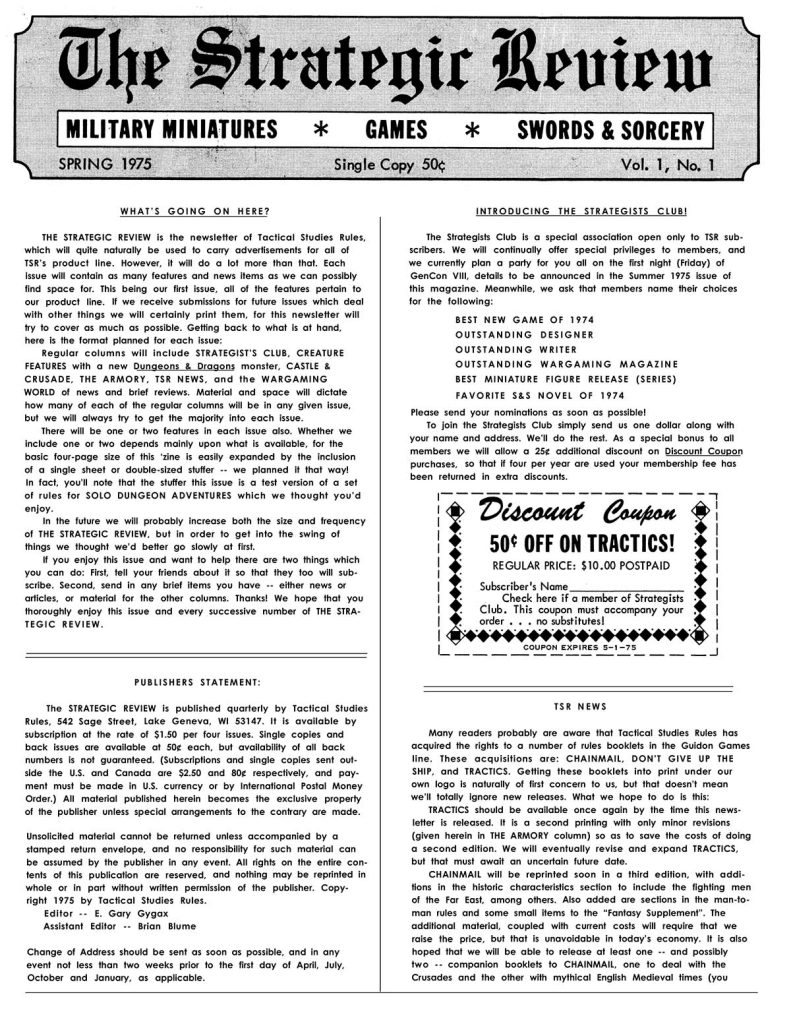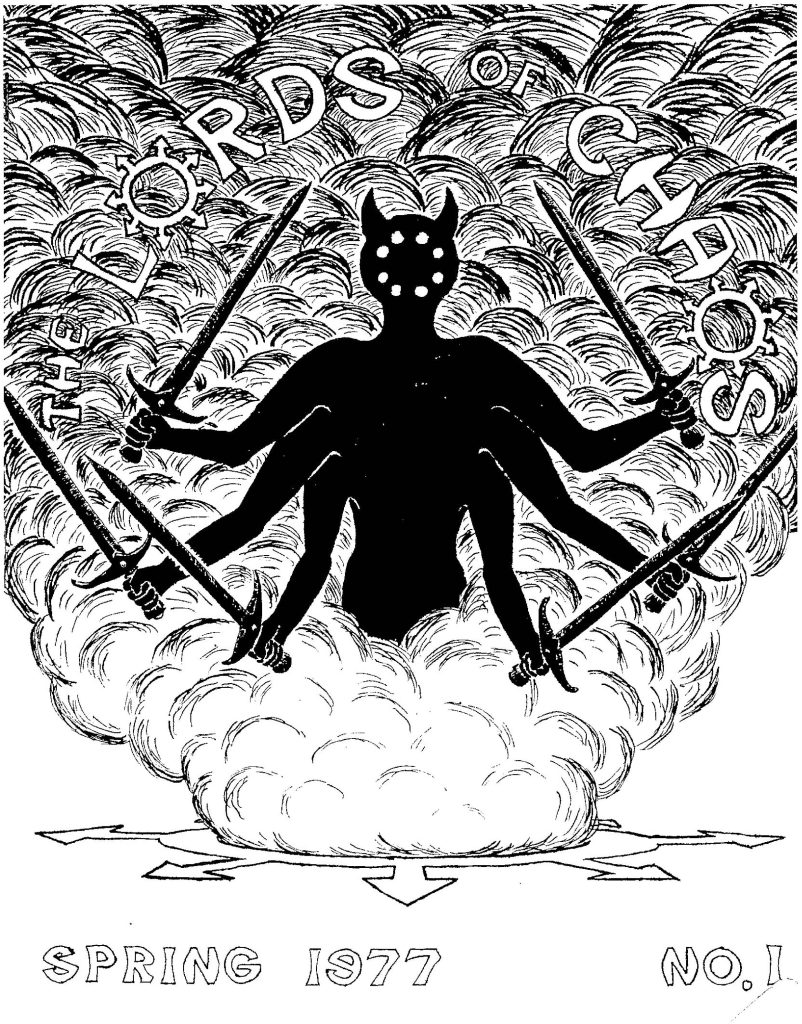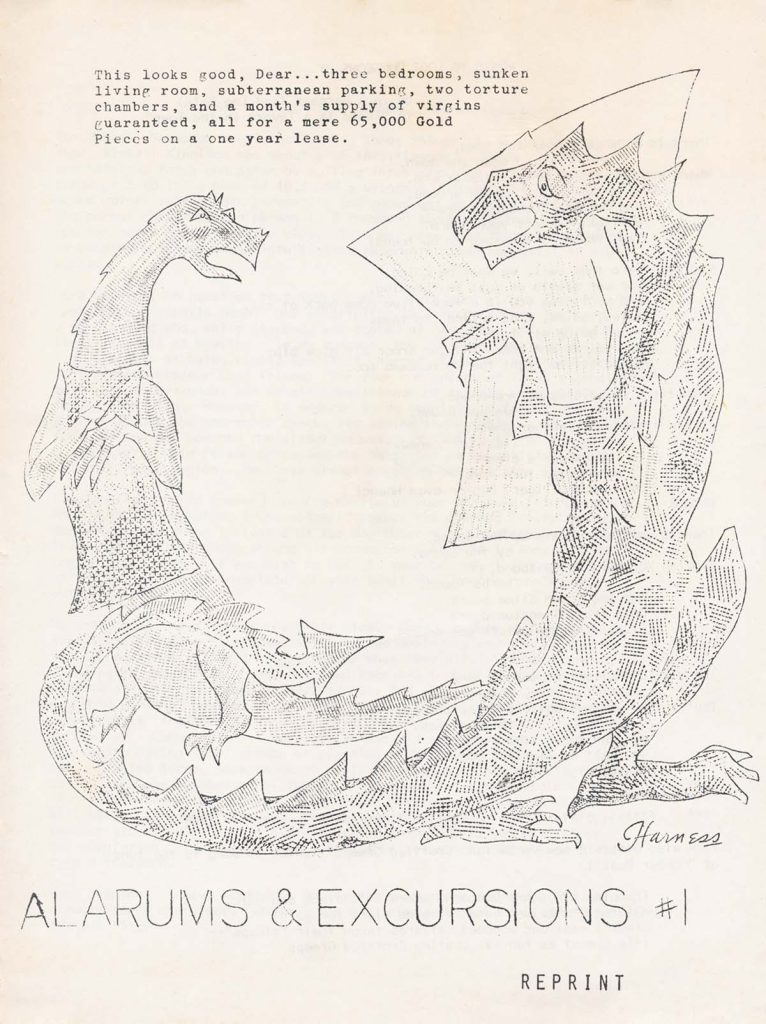This article was originally written as part of my roleplaying periodical project, to support a history and index for “Dragons Past” and “Son of Sartar”, two short APAs produced by Chaosium’s Greg Stafford. The overall periodical project includes indexes and histories of many roleplaying magazines (primarily focused on Chaosium & Traveller periodicals at the moment).

The history of roleplaying periodicals begins with TSR’s The Strategic Review (1975-1976), a newsletter first published in January 1975, less than a year after the debut of Dungeons & Dragons (1974). It joined older Diplomacy and wargame-related fanzines that were also integral to roleplaying’s early evolution, among them El Conquistador (1973-1975), Great Plains Game Players Newsletter (1972-1986?), Liaisons Dangereuses (1969-1977), and Wargamer’s Newsletter (1962-1980).
Following the publication of The Strategic Review, a new assemblage of non-wargaming ‘zines appeared. That began a few months later with The Space Gamer (1975-1985), a fantasy & science-fiction focused gaming magazine from Metagaming Concepts. Then, in June 1976, TSR rebooted The Strategic Review as a proper magazine, The Dragon (1976-2007), and Jennell Jaquays debuted The Dungeoneer (1976-1981). Bob Bledsaw and Bill Owens followed with the Judges Guild Journal (1976-1980) after that year’s Gen Con IX (1976). Meanwhile, Hartley Patterson was converting his News from Bree (1970-1988) from a fanzine about the Tolkien Society to one about roleplaying. By the end of 1976, the era of roleplaying periodicals had truly begun.
But that history of early roleplaying periodicals omits one crucial element: the Amateur Press Association, or APA. APAs are discussion-focused publications where each contributor supplies their own ‘zine. The individual ‘zines are then printed, collated, and collected together as a singular publication that is sent to the members. The idea dated back to the advent of the British Amateur Press Association (1890-1976), which was meant for amateur printers (hence the name!). By the ’70s, Science-fiction and fantasy-focused APAs were growing increasingly popular, and that would offer another on-road for the periodical publication of roleplaying content.
The Worlds of roleplaying and APAs first came together in Mike Wood’s MINNEAPA (1972-2000?), a very successful Minneapolis-focused APA that would include 300 members at its height. It was a successor to Louis “Blue Petal” Fallert’s Blue’s APA (1968-?), and in fact Fallert would be a founding member of the new ‘zine. That was important because Fallert had also played in a Blackmoor game in the Twin Cities and then reinvented the game as “Castle Keep”, which Craig VanGrasstek eventually published in a short run as Rules to the Game of Dungeon (1974), arguably the second roleplaying game (and even the second based on Arneson’s Blackmoor). Fallert began talking about his efforts in MINNEAPA #38 (February 1974), opening up the first APA discussion of FRPGs.
However, it was southern California APAs that would truly mold the future of roleplaying, in particular APA-L (1964-Present), a rare weekly APA founded by members of the Los Angeles Science Fiction Society. In APA-L #493 (October 1974), a member named Mark Swanson, formerly of Los Angeles but now at MIT, briefly reviewed Dungeons & Dragons. Discussion followed as an increasing number of members acquired and played Dungeons & Dragons. Rules to the Game of Dungeon got discussed too, due to membership overlap with MINNEAPA.
By APA-L #521 (May 1975) even the cover was D&D-themed, so it was no surprise when APA-L #523 (June 1975) announced that Lee Gold was starting a new APA focused entirely on D&D: Alarums & Excursions (1975-Present), which came out that same month, beating The Dragon and The Dungeoneer to print by exactly a year.
Alarums & Excursions was a hotbed for roleplaying discussion in the early industry. It contained descriptions of sessions, variant rules, and details of how to play. Though centered in Los Angeles, A&E included gamers such as Mark Swanson and Glenn Blacow in far away Boston and over the years would move beyond its geographic boundaries. Gary Gygax even published a few letters in early issues. Today, Alarums & Excursions is almost as old as the industry, and it’s included numerous designers among its members over the years, including Wilf K. Backhaus, Greg Costikyan, Dave Hargrave, Rob Heinsoo, Robin Laws, Jonathan Tweet, and many more, designers who have used A&E as somewhere to refine their design ideas and to meet other designers in the industry.
And, that wasn’t the industry’s only major APA. Three others of particular note.
The Wild Hunt (1976-1995). Glenn Blacow (who learned roleplaying from “Castle Keep”) and Mark Swanson (who introduced D&D to APA-L) soon founded their own East Coast RPG APA in Boston: The Wild Hunt. There were many other notable contributors, including Peter Aronson, who is most famous for the invention of the illusionist class, which was published in The Strategic Review #4 (Winter 1975). However, it was Blacow who wrote what might be the APA’s most famous article: in The Wild Hunt #50 (1980) he laid out one of the first taxonomies for RPGs, dividing them into role-playing, wargaming, ego-tripping, and story-telling. The Wild Hunt was quite long-lived, passing only when Blacow did. Peter Maranci’s Interregnum (1994-2001) succeeded it.

The Lords of Chaos (1977-1981). Another spin-off of A&E, the California-based Lords of Chaos was created by Niall Shapiro to focus on content for GMs (which was also the initial goal of The Wild Hunt, but Shapiro felt that it had failed and instead because a conversational forum, as was typical for APAs). Early contributors included Glenn Blacow, Lee Gold, and Mark Swanson, showing how intertwined the whole RPG APA scene was. Lords of Chaos ran just 13 issues on a quarterly basis; Shapiro himself later went on to design the Chaosium-influenced Other Suns (1983) RPG.
APA-DUD / Pandemonium (1977-1988). Although less well-known than the trio of A&E, TWH, and TLOC, Robert Sacks’ New York-based APA-DuD was quite long-lived as well. It was typically collated at The Compleat Strategist, a game store that was another foundation of the New York RPG scene. After APA-DUD #41 (November, 1980), the APA changed its name to Pandemonium and continued under that title through Pandemonium #125 (July-August 1988).
APAs began to die in the 80s due to the advent of computer bulletin boards and USENET news groups (followed by AOL, Compuserve, GEnie, internet forums, and many other forms of online communications). These are all the same factors that have tended to kill off magazines and fanzines too, because they offer much more immediate forms of communication, APAs just took the hit first. With that said, some of RPG’s top APAs obviously continued into the 90s, the 00s, and even into the present.
Of these APAs, Alarums & Excursions is the only one to get much attention nowadays. That’s in part because it’s still going, in part because it’s had so many famous designers move through its membership, and in part because its entire archives remain available from Lee Gold. Nonetheless, all of these APAs (and likely many more, beginning with MINNEAPA and APA-L) remain crucial to the history of the roleplaying industry.
APA References
Argothald. 2023. “Opening the Trunks, Part 2 — APAs”. The Argothald Journal. https://argothald.com/2023/11/06/opening-the-trunks-part-2-apas/.
Bucklin, Nate. 1983. “Mike Wood: 1948-1983”. Rune #72.
Gold, Lee. Date Unknown. “APA-L & Roleplaying”. Reprinted at https://www.greyhawkonline.com/grodog/temp/apa-l&roleplaying-lee_gold.doc.
Peterson, Jon. 2012. Playing at the World.
Peterson, Jon. 2012. “Rules to the Game of Dungeon.” Playing at the World blog. Peterson, Jon. 2020. The Elusive Shift. https://playingattheworld.blogspot.com/2012/08/rules-to-game-of-dungeon-1974.html.
Peterson, Jon. 2020. The Elusive Shift.
Shapiro, Niall. 1977. “Notes from the Underground #18.” Alarums & Excursions #24.
Various. Retrieved 2024. “APA-L.” Fancyclopedia 3. https://fancyclopedia.org/APA-L.


There were, of course, a ton of APAs for gaming and I know you wouldn’t be able to list them all but I was the Central Mailer for ‘All of the Above, the GURPS APA’. I can get you details once I have returned home and can access my copies.
Wow, hadn’t heard of that one. That’s a surprisingly late entry as it must have started in the mid to late 80s, after BBSes were already a thing and just before the first internet mailing lists started.
Yes, mid to late 80’s. I discovered zines from, I believe, an article in the Whole Earth Review which was written by Mike Gunderloy of Factsheet Five. From there, I discovered APAs. This was in the days of America Online (well before they opened their gateway to Usenet). I’ll get you some images. What was nice about AotA is that close to half of the members were folks that either wrote for SJGames, or later went on to write for SJGames.
I hope to launch an archive crowdfunding campaign in the next year. 🙂
That would be great to see. Let me know so that I can give it some attention too.
[…] at MIT at the time, meeting at the MIT Strategic Games Society. People like Mark Swanson, who then designed several D&D campaigns. Or Tim Anderson, a famous computer scientist that co-created Zork. These were also the first […]
[…] at MIT at the time, meeting at the MIT Strategic Games Society. People like Mark Swanson, who then designed several D&D campaigns. Or Tim Anderson, a famous computer scientist that co-created Zork. These were also the first […]